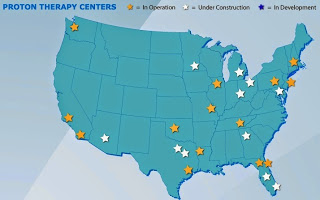| Online: | |
| Visits: | |
| Stories: |

| Story Views | |
| Now: | |
| Last Hour: | |
| Last 24 Hours: | |
| Total: | |
Evidence about proton beam efficacy
 |
| Source: The National Association for Proton Therapy |
Starting in 2011, I raised concerns about the proliferation of very expensive proton beam radiation therapy centers, made possible by investors who leverage the extra payments for use of this treatment modality that have been authorized by CMS and private insurers. I asserted, based on my contacts in the radiation therapy profession, that the use of proton beam technology offered no significant advantage over lower cost intensity-modulated radiation therapy (IMRT) in most cases. In short, I characterized proton beam developments as an example of the medical arms race, a rush by hospitals to compete on a high cost approach that offered little value to the public.
Now comes a thoughtful analysis published by the Health Technology Assessment Program of the Washington State Health Care Authority: Proton Beam Therapy, Final Evidence Report. The analysis was carried out by the Institute for Clinical and Economic Review (ICER), an independent non-profit health care research organization “dedicated to improving the interpretation and application of evidence in the health care system.”
First, ICER gives the context for the early interest in this modality:
Initial use of proton beam therapy (PBT) focused on conditions where sparing very sensitive adjacent normal tissues was felt to be of utmost importance, such as cancers or noncancerous malformations of the brain stem, eye, or spinal cord. In addition, proton beam therapy was advocated for many pediatric tumors because even lower-dose irradiation of normal tissue in pediatric patients can result in pronounced acute and long-term toxicity (Thorp, 2010). There are also long-standing concerns regarding radiation’s potential to cause secondary malignancy later in life, particularly in those receiving radiation at younger ages. Finally, radiation may produce more nuanced effects in children, such as neurocognitive impairment in pediatric patients treated with radiotherapy for brain cancers (Yock, 2004).
Then, they set up the current issue of concern:
The construction of cyclotrons at the heart of proton beam facilities is very expensive ($150-$200 million for a multiple gantry facility); accordingly, as recently as 10 years ago there were fewer than 5 proton beam facilities in the United States (Jarosek, 2012). More recently, however, the use of PBT has been expanded in many settings to treat more common cancers such as those of the prostate, breast, liver, and lung. With the growth in potential patient numbers and reimbursement, the construction of proton centers has grown substantially. There are now 14 operating proton centers in the U.S. Eleven additional centers are under construction or in the planning stages, and many more are proposed.
The bulk of the report looks at the best available evidence:
We focused primary attention on randomized controlled trials and comparative cohort studies that involved explicit comparisons of PBT to one or more treatment alternatives and measures of clinical
effectiveness and/or harm.
The summary:
We judged PBT to have superior net health benefit for ocular tumors, and incremental net health benefit for adult brain/spinal tumors and pediatric cancers. We felt PBT to be comparable to alternative treatment options for patients with liver, lung, and prostate cancer as well as one noncancerous condition (hemangiomas). Importantly, however, the strength of evidence was low for all of these conditions. We determined the evidence base for all other condition types to be insufficient to determine net health benefit, including two of the four most prevalent cancers in the U.S.: breast and gastrointestinal (lung and prostate are the other two).
Not exactly a ringing endorsement for adding billions of dollars to America's health care budget. The original concept behind PBT was to have just a few across the country, to which patients who could most benefit would travel. The idea was not to have as many as currently exist and are as planned.
The result published by ICER hold little sway with the hospitals that have bought these machines. Here's a sample web page from the The University of Florida Health Proton Therapy Institute:
In case you can't read the small image, it says:
Proton radiation is most effective in the treatment of localized cancers that have not metastasized or spread to other parts of the body.
These include:
- Breast cancer
- Prostate cancer
- Head and neck cancer
- Cancer in children
- Lung cancer
- Brain cancer
- Pancreatic cancer
- Lymphoma
- Sarcoma
- Eye cancer
Click through on any of those links and you can find clinically unsupported assertions about the benefits of this technology. Taking prostate as an example:
Traditional prostate cancer treatment involving surgery or radiation carries the risk of serious toxicity and side effects. The potential long-term impact of these side effects on quality of life forces men to make a difficult choice during a stressful time. Proton radiation for prostate cancer treatment, however, offers an innovative method of radiation treatment intended to lower the risk of prostate cancer treatments and side effects.
For treating cancer of the prostate, proton therapy offers multiple benefits:
- Excellent control of tumors, thanks to more precise targeting of radiation
- Lower risk of damage to healthy tissue surrounding the prostate cancer
- Better quality of life for patients undergoing prostate proton therapy treatments
An alternative to traditional prostate cancer treatment, proton radiation for prostate cancer delivers precise doses of radiation with a lower risk of side effects.
With ICER's help, we now see that this verbiage is a lie.
So what we have in place in America is simply this:
Federal reimbursement policy supports the construction and operation of high cost, unnecessary machines.
Investment bankers rely on the above to offer hospitals financing plans, operational plans, and marketing plans for something the public doesn't need.
Hospitals engage in direct-to-consumer advertising in which they present misleading and inaccurate information about the benefits of the machines.
And we wonder why US health care costs keep rising.
Source: http://runningahospital.blogspot.com/2015/05/evidence-about-proton-beam-efficacy.html




